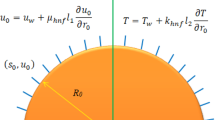Abstract
The effect of feedback on mixing in a plane shear layer was studied using temperature as an analog to species concentration. Mixing was quantified using temperature measurements made by an array of cold-wire sensors. Upstream of the cold-wire sensors, a schlieren imager measured the cross-stream position of the temperature interface between the two streams before the primary vortical structures had formed. Surface heaters mounted on the flow partition were used as control actuators. Feeding the gained output from the interface position sensor back to the surface heaters closed the loop and created resonance and out-of-resonance conditions in the flow, both of which increased mixing. The feedback gains were adaptively modified in real time to maximize mixing at a given streamwise station. Finally, it was found that deliberately introducing streamwise vorticity, and then choosing feedback gains that strengthen these streamwise vortices, can greatly enhance mixing.




























Similar content being viewed by others
References
Dimotakis PE (1989) Turbulent free shear layer mixing. AIAA Paper 89-0262
Dimotakis PE (1991) Turbulent free shear layer mixing and combustion. High speed flight propulsion systems. Prog astronaut aeronaut 137(5):265–340
DiStefano J, Stubberud A, Williams I (1990) Schaum’s outline of feedback and control systems. McGraw-Hill, NY
Doyle J, Francis B, Tannenbaum A (1990) Feedback control theory. Macmillan, NY
Ffowcs Williams JE, Möhring W (2000) Control action for stabilizing free shear flows. J Fluid Mech 404:27–46
Gaster M (1986) A non-linear transfer function description of wave growth in a boundary layer. In: Proceedings of the fourth international conference on boundary and interior layers, July 7–11, 1986, Novosibirsk, USSR, pp 107–114
Ho C-M, Huerre P (1984) Perturbed free shear layers. Ann Rev Fluid Mech 16:365–424
Huang L-S, Ho C-M (1990) Small-scale transition in a plane mixing layer. J Fluid Mech 210:475–500
Ikeda Y (1998) Real-time active flow control based on modern control theory. AIAA Paper 98-2911
Katch GJ, Koochesfahani MM (1993) Mixing of species in a two-stream shear layer forced by an oscillating airfoil. AIAA Paper 93-0444
Koochesfahani MM, Dimotakis PE (1988) A cancellation experiment in a forced turbulent shear layer. AIAA Paper 88-3713-CP
Koochesfahani MM, MacKinnon CG (1991) Influence of forcing on the composition of mixed fluid in a two-stream shear layer. Phys Fluids A3(5):1135–1142
Liepmann HW, Nosenchuck DM (1982) Active control of laminar-turbulent transition. J Fluid Mech 118:201–204
Liepmann HW, Brown GL, Nosenchuck DM (1982) Control of laminar instability waves using a new technique. J Fluid Mech 118:187–200
Monkewitz PA (1989) Feedback control of global oscillations in fluid systems. AIAA Paper 89-0991
Nygaard KJ, Glezer A (1991) Evolution of streamwise vortices and generation of small-scale motion in a plane shear layer. J Fluid Mech 231:257–301
Oster D, Wygnanski I (1982) The forced mixing layer between parallel streams. J Fluid Mech 123:91–130
Pierrehumbert RT, Widnall SE (1982) The two- and three-dimensional instabilities of a spatially periodic shear layer. J Fluid Mech 114:59–82
Reisenthel P (1988) Hybrid instability in an axisymmetric jet with enhanced feedback. Ph.D. dissertation, Illinois Institute of Technology, Chicago
Roberts FA, Roshko A (1985) Effects of periodic forcing on mixing in turbulent shear layers and wakes. AIAA Paper 85-0570
Wang G-H, Clements NT, Barlow RS, Varghese PL (2007) A system model for assessing scalar dissipation measurement accuracy in turbulent flows. Meas Sci Technol 18:1287–1303
Wehrmann OH (1965) Tollmien–Schlichting waves under the influence of a flexible wall. Phys Fluids 8:1389–1390
Wehrmann OH (1967) Self-adjusting feedback loop for mechanical systems to influence flow in transition; part I. Document D1-82-0632. Boeing Scientific Research Laboratories
Wiltse JM, Glezer A (2004) Scalar mixing in a forced non-reactive plane shear layer using a thermal analogue to species concentration. J Fluid Mech 506:369–406
Wyngaard JC (1971) Spatial resolution of a resistance wire temperature sensor. Phys Fluids 14:2052–2054
Acknowledgments
The authors would like to acknowledge several useful discussions with Professor Arne Pearlstein.
Author information
Authors and Affiliations
Corresponding author
Rights and permissions
About this article
Cite this article
Wiltse, J.M., Glezer, A. The effect of closed-loop feedback control on scalar mixing in a plane shear layer. Exp Fluids 51, 1291–1314 (2011). https://doi.org/10.1007/s00348-011-1139-6
Received:
Revised:
Accepted:
Published:
Issue Date:
DOI: https://doi.org/10.1007/s00348-011-1139-6




